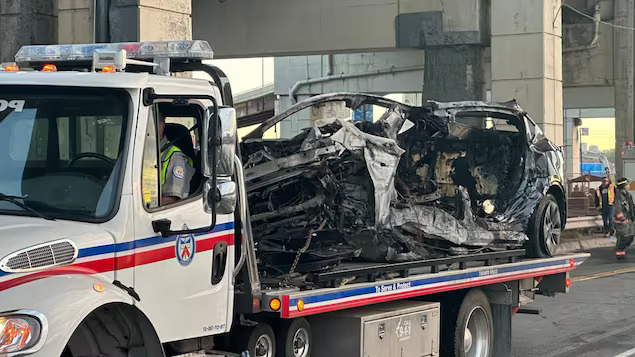Canada News
A deadly crash in Toronto raises questions about the dangers when things go wrong for EVs
By Lisa Xing, Geoff Nixon, CBC News, RCI

A recent Toronto crash that left four people dead inside a Tesla and a sharp rise in e-bike battery fires are among the incidents prompting serious concern about EV safety as electric vehicle sales continue to rise in Canada. Photo: (Meagan Fitzpatrick/CBC)
Deadly Oct. 24 crash in downtown Toronto killed 4
A deadly crash involving an electric car that killed four people in downtown Toronto has raised concerns about the dangers when things go wrong for EVs.
That includes whether people can easily extract themselves in the event of a fire, or how significant the fire risk is among the current generation of EVs.
Observers say these types of fires may draw media attention, but they aren’t that common — and that analysis of EV safety should focus on products and their components, and any resulting concerns.
The Toronto crash
The deadly Toronto crash occurred in the early hours of Oct. 24 and involved a Tesla that struck a guardrail (new window), then a concrete pillar and caught on fire.
The crash remains under investigation, and the full circumstances aren’t yet known.
A witness told CBC News that the vehicle’s doors appeared to be inoperable from the outside in the wake of the crash. Only one person survived, with help from fellow motorists who happened upon the scene.
Rick Harper, a Canada Post tractor-trailer driver, helped smash a window on the burning Tesla, allowing the lone survivor to get out. He says none of the car doors could be opened from the outside.
At least I was there with something we could break the window with and save the young lady,
he said.
The look in her eyes, the terror still affects me.
Tesla did not respond to a request for comment from CBC News.
The company’s door handles are electronic, it says on its site (new window), and cannot be operated without power. In those cases, the passenger must use manual release mechanisms, which vary among models.
With so many details unknown about the Toronto crash, it’s unclear what the other passengers’ conditions were in the moments after, and whether they could operate the releases.
It’s conceivable, however, that a driver might have a better knowledge of a car’s workings than their passengers — and that could factor into how they react in the aftermath of a crash, said George Iny of the Automobile Protection Association (APA).
Getting out
It’s very unlikely, especially [as] a rear-seat passenger … that you would even know where the manual override is, certainly less so in a panic situation or if you’re injured,
said Iny.
His organization would prefer conventional door handles for these vehicles.
The countervailing argument is that: ‘Well, if the vehicle is crushed partially after a collision, the door won’t open, anyway,
said Iny.
There’s still something to be said in favour of an old, manual door handle that you can pull.
Social media videos show the mechanical release could be difficult to find, especially in the rear of a car. In some models, like the Tesla Model X (new window), a person has to pry open the cover of a speaker located on the side of the door and locate a wire to pull.
Olivier Trescases, director of the University of Toronto’s Electric Vehicle (UTEV) Research Centre, mentions another solution — a supercapacitor, which would allow parts like the doors to hold a bit of charge even with the power cut off.
Right now, some premium
cars have it, but it’s not required in all vehicles. He says it’s always a trade-off of cost versus safety.
He also says, generally, the more premium
the car is, the safer it is, too, which he acknowledges is controversial.
EVs and their gasoline counterparts
Trescases said that EVs are generally much safer
than their gasoline counterparts, when it comes to likelihood of a catastrophic fire. He said gasoline carries more energy density and is generally more flammable than lithium batteries are. EVs also have systems in place to monitor the batteries’ function.
Firefighters across the country are nonetheless adapting to the reality of having to deal with EV fires.
That’s because when they do occur, they can be more challenging to control, said Ken McMullen, president of the Canadian Association of Fire Chiefs. And with more EVs on the roads, it means emergency crews will have to change the way they respond to incidents.
They’re hotter than what we would typically have as a normal combustible fire. They burn hotter and they spread quicker,
said McMullen, who is also the chief of emergency services in Red Deer, Alta.
Better protections needed
The APA’s Iny wants drivers better protected — including when it comes to battery fires.
He said that while the overall numbers of fires of this nature may be low, there’s a high sensitivity among automakers about the issue.
We need to take advantage of that greater awareness or alertness right now, to step up our investigations and the responses, as well,
Iny said.
He also noted that the current wave of early EV adopters will eventually be joined by a larger group of newer users, who may be less aware of their vehicles’ issues.
The Canadian government has set an ambitious target (new window) of making all new vehicles sales zero emissions by 2035. That makes any unsettled concerns about electric vehicles all the more pressing.
Varying standards for EVs, e-bikes
Toronto Fire has said the number of fires reported involving lithium-ion batteries was up about 90 per cent in 2023 (new window) over the previous year, to 55. However, many involved e-bikes, as opposed to electric cars.
Researchers say the bikes’ battery quality isn’t necessarily the same as in passenger vehicles.
There are a few major studies that show that, per 100,000 vehicles, EVs are much safer, and so it comes down to the standards, the control systems,
said Trescases, the UTEV director.
“In some cases, we see fires of small electric vehicles like scooters and e-bikes, because they don’t have the same quality standards, they don’t have the same monitoring systems.
Unfortunately, they give a kind of bad rap to EVs.
However, he says there are certain situations that are completely isolated to electric vehicles that, though rare, drivers should know about, including that salt water in a battery can cause fires.
That is something that has no analogy to combustion vehicles,
he said. You will never see a traditional vehicle just sitting there and spontaneously combust.
Quality control, oversight
Some observers are still calling for better quality control.
Josipa Petrunic, CEO of the Canadian Urban Transit Research & Innovation Consortium, said there needs to be more oversight over battery quality.
Almost all of the obligation lands on automotive companies … to check the quality of those battery packs, before they find their way into your vehicle,
Petrunic said.
Transport Canada told CBC News it has regulated vehicles with high voltage propulsion systems
for more than two decades and its standards require testing to ensure such systems do not pose a risk to occupants post-crash.
It also said it’s involved in developing global regulations for electric vehicle safety.
This article is republished from RCI.





















